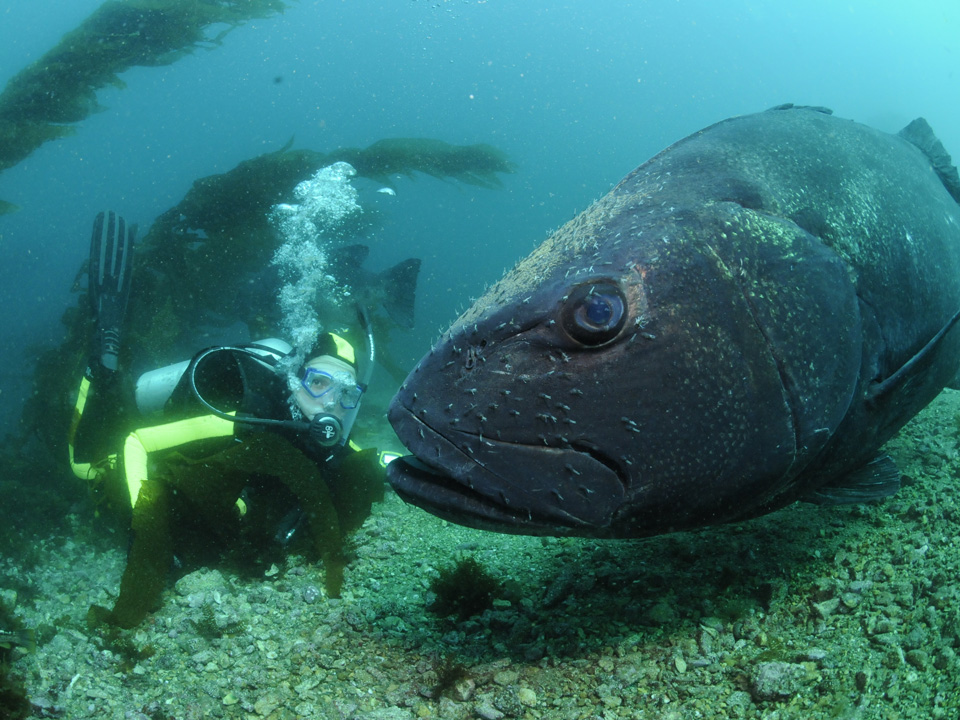
If you’ve ever dived off Casino Point in Catalina, it’s possible you have encountered one of the most magnificent fish ever to ply the cold waters of California. The Giant Sea Bass, also known as Stereolepis gigas, has long been a majestic part of California’s coastal ecosystems. This behemoth of a fish can grow up to nearly 7 and a half feet long, weighing a whopping 560 pounds, and can live to the age of 75. These gigantic, slow-moving sea creatures were once a common sight in the coastal waters of Southern California, particularly around Catalina Island. However, overfishing in the 20th century dramatically reduced their populations to critically low levels. Now, thanks to conservation efforts, these gentle giants are making a triumphant, albeit precarious, return. This is their story of recovery and resilience.

The plight of the Giant Sea Bass is a familiar story in the annals of marine conservation. Abundant in the early 1900s, they were targeted by both commercial and recreational fishers. Their large size and slow-moving nature made them an easy and attractive target. Overfishing led to a sharp decline in their numbers. By the 1970s, sightings had become rare, sparking concerns about the species’ survival.
However, the Giant Sea Bass was not ready to fade away into history. The California Department of Fish and Wildlife stepped in during the 1980s, implementing measures to protect the species. A ban was placed on commercial and recreational fishing, and a concerted effort was made to restore their habitat around the Southern California coast, especially around Catalina Island.

The breeding population of giant sea bass — which is listed as critically endangered by the International Union for Conservation of Nature — is believed to be only about 500 individuals. But since the ban on fishing and the launch of habitat restoration projects, the Giant Sea Bass has been on a steady journey towards recovery. Research groups and marine scientists have been monitoring their numbers around Catalina Island, a critical habitat for the species. Much of the work has been done at the Wrigley Marine Science Center (WMSC), the USC Wrigley Institute for Environmental Studies’ satellite campus on Santa Catalina Island. They’ve been using a variety of methods, including underwater surveys and remotely operated vehicles (ROVs), to track the population.
Their work has yielded promising results. The number of Giant Sea Bass sightings has been steadily increasing over the years. Juvenile Giant Sea Bass have also been spotted, a positive sign that the species is breeding successfully. These observations suggest that their populations are recovering, albeit slowly.
In 2019 California State University, Northridge (CSUN), the Aquarium of the Pacific, and Cabrillo Marine Aquarium announced a successful joint effort involving raising and releasing juvenile giant sea bass into the ocean. For this project, CSUN shared giant sea bass eggs in an attempt to produce offspring. Three juveniles were raised at the Aquarium of the Pacific, and the Cabrillo Marine Aquarium successfully reared hundreds of baby giant sea bass babies from these eggs. In March 2020, 200 baby giant sea bass were released into the murky waters of Santa Monica Bay.

Catalina Island, a jewel in Southern California’s marine landscape, is another big part of this conservation success. The island’s surrounding waters offer the perfect habitat for the Giant Sea Bass, with its ample kelp forests and rocky reefs, not to mention the ocean tends to be much cleaner around Catalina than along the mainland coast. The island’s commitment to marine conservation, exemplified by the Catalina Island Conservancy and its partners, has provided the ideal conditions for the species to rebound.
In addition to the protective regulations, the Island’s community has embraced their role as stewards of their marine environment. Local scuba divers often act as citizen scientists, providing valuable data through sightings and photographs of the Giant Sea Bass. We at California Curated have seen several of them while diving, gaping in awe as they hover like zeppelins in the kelp beds of Casino Point.

CALIFORNIA CURATED ART ON ETSY
Purchase stunning art prints of iconic California scenes.
Check out our Etsy store.
Researchers who have been studying large fish in Southern California for decades say persistence is key to successful conservation efforts for giant sea bass. Although their numbers have increased, they are only about 20% of what’s needed for long-term survival. Researchers understands fishers’ frustrations but believe the fishing ban must remain for 20-30 more years to prevent repeating past overfishing. Since giant sea bass take 11-13 years to reach maturity, their recovery is slow, and even a few boats could severely impact the current population.
The return of the Giant Sea Bass is a beacon of hope, reminding us of the resilience of nature when given a chance to recover. But the journey is far from over. While their numbers are increasing, the Giant Sea Bass still faces threats, including pollution, habitat degradation, and the looming challenges of climate change.

Conservationists argue that the Giant Sea Bass’s recovery illustrates the importance of a multi-faceted approach to marine conservation. Protective legislation, habitat restoration, scientific research, and community engagement all played critical roles in this success story.
Although the story is far from over and recovery is incomplete, the story of the Giant Sea Bass stands as a testament to the impact of conservation, of thinking hard and acting on the protection of species and fragile environments. Continued research, monitoring, and community engagement will be essential to ensure the long-term survival of the giant sea bass. Their resurgence offers a valuable opportunity to learn from our past mistakes and work together to ensure a brighter future for these gentle giants and the marine ecosystems they call home.







